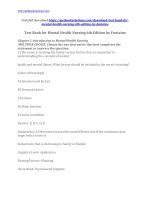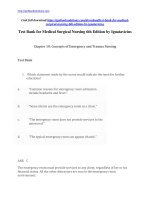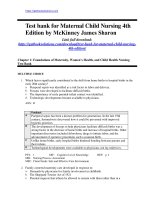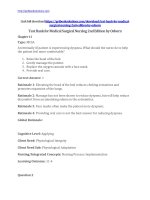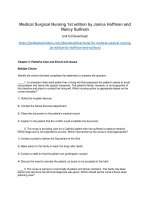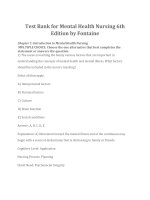Test bank for medical surgical nursing 2nd edition by osborn
Bạn đang xem bản rút gọn của tài liệu. Xem và tải ngay bản đầy đủ của tài liệu tại đây (534.94 KB, 20 trang )
Link full download: />
Test Bank for Medical Surgical Nursing 2nd Edition by Osborn
Chapter 11
Type: MCSA
A terminally ill patient is experiencing dyspnea. What should the nurse do to help
the patient feel more comfortable?
1.
2.
3.
4.
Raise the head of the bed.
Gently massage the patient.
Replace the oxygen cannula with a face mask.
Provide oral care.
Correct Answer: 1
Rationale 1: Elevating the head of the bed reduces choking sensations and
promotes expansion of the lungs.
Rationale 2: Massage has not been shown to reduce dyspnea, but will help reduce
discomfort from accumulating edema in the extremities.
Rationale 3: Face masks often make the patient more dyspneic.
Rationale 4: Providing oral care is not the best answer for reducing dyspnea.
Global Rationale:
Cognitive Level: Applying
Client Need: Physiological Integrity
Client Need Sub: Physiological Adaptation
Nursing/Integrated Concepts: Nursing Process: Implementation
Learning Outcome: 11-4
Question 2
Type: MCSA
A competent elderly patient has a living will that specifies avoiding resuscitation
and heroic life support measures. The family members are not supportive of this
directive. Which action by the nurse is most appropriate?
1. Consider the document valid and document its existence in the medical
record.
2. Contact the Social Services department.
3. Notify the hospital attorney.
4. Explain to the patient that the conflict could invalidate the document.
Correct Answer: 1
Rationale 1: The patient is competent. The nurse should consider this document
valid and should advocate for the patient’s wishes by including the information in
the medical record.
Rationale 2: If there are concerns about the authenticity of the document, the Social
Services department or the unit supervisor will need to be contacted.
Rationale 3: The nurse would not contact the hospital attorney but would make the
situation known to the unit supervisor.
Rationale 4: A lack of support by the family does not invalidate the document.
Global Rationale:
Cognitive Level: Analyzing
Client Need: Safe Effective Care Environment
Client Need Sub: Management of Care
Nursing/Integrated Concepts: Nursing Process: Implementation
Learning Outcome: 11-2
Question 3
Type: MCSA
While preparing for the discharge of an elderly, terminally ill patient, the family asks
for information concerning the most appropriate time to become involved with a
hospice agency. Which action by the nurse is most appropriate?
1. Assist the family in making contact with a hospice agency at this time.
2. Estimate the patient’s life expectancy to gauge when contact with hospice
should be made.
3. Encourage the family to “hold off” making the contact until death is very close.
4. Determine what expectations the family has of the hospice agency.
Correct Answer: 1
Rationale 1: Hospice agencies provide vital services to patients who are facing
death and to their families. Referrals should be prompt.
Rationale 2: Even though a hospice is generally considered appropriate in the last 6
months of life, it is not appropriate for the nurse to make that determination.
Rationale 3: Waiting until the time of death is at hand does not leave much time for
the hospice agency to assist the family.
Rationale 4: Determining the family’s expectations is an action more appropriate
for the hospice intake nurse.
Global Rationale:
Cognitive Level: Applying
Client Need: Safe Effective Care Environment
Client Need Sub: Management of Care
Nursing/Integrated Concepts: Nursing Process: Implementation
Learning Outcome: 11-5
Question 4
Type: MCSA
A terminally ill patient is receiving palliative care. How would the nurse explain the
purpose of this type of care to the family?
1. “Palliative care is designed to alleviate suffering and promote quality of life.”
2. “Palliative care reduces pain and prevents medical complications.”
3. “Palliative care’s purpose is to control the side effects of illness while
postponing death.”
4. “Palliative care involves withdrawing all medical care to allow natural death.”
Correct Answer: 1
Rationale 1: The purpose of palliative care is to provide comprehensive care
focused on alleviating suffering and promoting quality of life.
Rationale 2: Medical complications can be controlled by palliative care, but not
prevented. Palliative care can also help control pain.
Rationale 3: The purpose of palliative care is not specifically to postpone death.
Rationale 4: Withdrawing all medical care would be inappropriate, as it would
cause more suffering.
Global Rationale:
Cognitive Level: Analyzing
Client Need: Safe Effective Care Environment
Client Need Sub: Management of Care
Nursing/Integrated Concepts: Nursing Process: Implementation
Learning Outcome: 11-6
Question 5
Type: MCSA
A patient asks the nurse what it means to have hospice care at home. What is the
most accurate response to this patient?
1.
2.
3.
4.
“Hospice makes sure that you are comfortable at home.”
“Hospice care helps cure your illness.”
“Hospice care is for patients who will be sick for longer than a year.”
“Hospice care means all your needs will be met.”
Correct Answer: 1
Rationale 1: Hospice care focuses on comfort care versus curative care.
Rationale 2: Hospice care does not focus on cure.
Rationale 3: Patients receiving hospice care are generally defined as patients who
have a prognosis of 6 months or less if their terminal disease runs a normal course.
Rationale 4: The nurse cannot guarantee that all needs will be met.
Global Rationale:
Cognitive Level: Applying
Client Need: Safe Effective Care Environment
Client Need Sub: Management of Care
Nursing/Integrated Concepts: Nursing Process: Implementation
Learning Outcome: 11-5
Question 6
Type: MCSA
A patient with a chronic illness who is receiving palliative care asks the nurse if a
newly prescribed medication will cure the disease. What is the nurse’s best
response?
1. “It will help you be more comfortable. I don’t think it’s going to cure the
disease.”
2. “Of course it’s going to cure the disease.”
3. “If you believe it will cure the disease, then it will.”
4. “I don’t think it’s going to help or hurt at this time.”
Correct Answer: 1
Rationale 1: In palliative care, the nurse should be honest with the patient and
explain that the medication will help with comfort, but it will not cure.
Rationale 2: In palliative care, the nurse should be honest with the patient and
explain that the medication will not cure the disease.
Rationale 3: The nurse should not approach palliative care as curative because this
could rob the patient of time and closure at the end of life.
Rationale 4: The nurse has no way of knowing the effect of the medication as far as
helping or hurting the illness progression.
Global Rationale:
Cognitive Level: Applying
Client Need: Psychosocial Integrity
Client Need Sub:
Nursing/Integrated Concepts: Nursing Process: Implementation
Learning Outcome: 11-6
Question 7
Type: MCSA
Several visitors are in the room of a terminally ill patient. The nurse enters the room
to discuss the plan of care for the patient. Which actions should be taken?
1. Stand at the foot of the patient’s bed and tell all present the best course of
action.
2. Ask the patient which individuals he or she would like to have stay in the
room.
3. Ask the other patient in the room to raise the volume of the television.
4. Sit down next to the patient and discuss the plan.
Correct Answer: 2
Rationale 1: The nurse should not assume that everyone in the room is supposed to
hear the plan of care.
Rationale 2: Just because the patient is terminally ill does not mean that privacy is
no longer an issue. The nurse should continue to honor the patient’s wishes.
Rationale 3: If the roommate cannot leave the room, the nurse should draw the
curtain and speak in quiet tones.
Rationale 4: Sitting next to the patient does not necessarily ensure privacy.
Global Rationale:
Cognitive Level: Analyzing
Client Need: Safe Effective Care Environment
Client Need Sub: Management of Care
Nursing/Integrated Concepts: Nursing Process: Implementation
Learning Outcome: 11-1
Question 8
Type: MCSA
A terminal patient with a fulminating leg wound needs surgery, yet it is unlikely the
patient will survive the procedure. The nurse could ethically support which action
by the health care team?
1. Explaining that the surgery is needed and every effort will be done to keep
the patient alive
2. Deciding not to conduct the surgery and determining if there are other
treatment approaches
3. Telling the patient that offering surgery was an error and that treatment will
be done with medications and therapy
4. Conducting the surgery without telling the patient that survival is unlikely.
Correct Answer: 2
Rationale 1: The surgery should not be done with the promise of keeping the
patient alive. If the patient is likely to die, this violates the ethical principle of
veracity.
Rationale 2: Surgical intervention is stressful and painful. If the patient is not likely
to survive the surgery, it should not be performed. The ethical action is to determine
if other treatment approaches exist.
Rationale 3: Lying to the patient is not ethical and should not be supported by the
nurse.
Rationale 4: This is unethical conduct. The patient should be taken to surgery only
if informed consent is valid.
Global Rationale:
Cognitive Level: Applying
Client Need: Safe Effective Care Environment
Client Need Sub: Management of Care
Nursing/Integrated Concepts: Nursing Process: Planning
Learning Outcome: 11-1
Question 9
Type: MCSA
The family of an incapacitated patient desires one course of treatment that
contradicts the decisions of the person with durable power of attorney. The
disagreement is affecting the patient’s nursing care. What should the nurse do?
1. Tell the person with durable power of attorney that he has to get the family’s
consent.
2. Follow the family’s desires.
3. Provide care according to the decisions of the person with durable power of
attorney.
4. Ask the physician to talk with the family and the person with durable power
of attorney.
Correct Answer: 3
Rationale 1: The person appointed to make medical decisions does not need
consent from other family members or friends.
Rationale 2: Following the family’s desires is not advocating for the patient’s
directions.
Rationale 3: A durable power of attorney for health care allows the patient to
appoint a decision maker in case of future incapacity. The durable power of attorney
specifically states which powers the patient gives to the surrogate decision maker,
and those decisions are to be followed even when they conflict with family
members’ desires.
Rationale 4: The nurse should make decisions about the nursing care of the patient.
The physician makes decisions related to medical care and discusses them with the
family.
Global Rationale:
Cognitive Level: Applying
Client Need: Safe Effective Care Environment
Client Need Sub: Management of Care
Nursing/Integrated Concepts: Nursing Process: Planning
Learning Outcome: 11-2
Question 10
Type: MCSA
The nurse is preparing an analgesic infusion for a cancer patient who is in pain and
is nearing the end of life. What should the nurse do to ensure this patient’s comfort?
1. Titrate the medication to help with pain relief and not hasten the dying
process.
2. Use meperidine in the infusion.
3. Limit the amount of medication infused.
4. Contact the pharmacy for the correct dose to provide the patient.
Correct Answer: 1
Rationale 1: The nurse should titrate the medication to reduce the patient’s pain
but not hasten the dying process.
Rationale 2: Meperidine is not recommended for pain because it could cause
seizures.
Rationale 3: The patient may have been receiving pain medication for cancer
treatment and may have some tolerance to the medication. Limiting the amount of
medication infused will result in inadequate pain control.
Rationale 4: There is no set dosage for pain medications at the end of life.
Global Rationale:
Cognitive Level: Applying
Client Need: Physiological Integrity
Client Need Sub: Pharmacological and Parenteral Therapies
Nursing/Integrated Concepts: Nursing Process: Implementation
Learning Outcome: 11-3
Question 11
Type: MCSA
A patient is experiencing delirium. Which group of medications should the nurse
consider administering to help reduce delirium?
1.
2.
3.
4.
Neuroleptics
Benzodiazapines
NSAIDs (nonsteroidal anti-inflammatory drugs)
Opioids
Correct Answer: 1
Rationale 1: Neuroleptics such as Haldol help reduce the symptoms of delirium.
Rationale 2: Benzodiazapines are used for sedation and to prevent seizures.
Rationale 3: NSAIDs are helpful for treating inflammation, pain, and fever rather
than delirium.
Rationale 4: Opioids are used for relief of pain and dyspnea.
Global Rationale:
Cognitive Level: Applying
Client Need: Physiological Integrity
Client Need Sub: Pharmacological and Parenteral Therapies
Nursing/Integrated Concepts: Nursing Process: Implementation
Learning Outcome: 11-3
Question 12
Type: MCSA
The nurse is planning palliative care for a patient with severe atherosclerotic
disease. What is the highest priority for this patient?
1.
2.
3.
4.
Tolerance of physical activity
Use of available financial resources
Redesigning the patient’s home to support assistive devices
Pain and symptom management
Correct Answer: 4
Rationale 1: Tolerance of physical activity is a low priority for this patient.
Rationale 2: Using available financial resources is not the highest priority.
Rationale 3: Home environment redesign is not the highest priority for this patient.
Rationale 4: When providing care to patients in a palliative care program, targeted
interventions are common and include pain and symptom management, end-of-life
care planning, and interventions to support the patient’s psychosocial and spiritual
needs.
Global Rationale:
Cognitive Level: Analyzing
Client Need: Psychosocial Integrity
Client Need Sub:
Nursing/Integrated Concepts: Nursing Process: Planning
Learning Outcome: 11-6
Question 13
Type: MCSA
Which nursing intervention follows the principles of palliative care?
1.
2.
3.
4.
Encouraging physical therapy to restore prior level of functioning
Talking to the patient about plans for funeral arrangements
Talking to the patient about possibly becoming an organ donor
Facilitating a consult to promote weight gain
Correct Answer: 2
Rationale 1: Attempting to return to a prior level of functioning is not the goal of
palliative care.
Rationale 2: Palliative care focuses on pain and symptom management, end-of-life
planning, and psychosocial as well as spiritual needs. Encouraging end-of-life
planning such as funeral plans would be very appropriate.
Rationale 3: Organ donation is only possible when a patient experiences brain
death on life support. This is not the goal of palliative care.
Rationale 4: Encouraging weight gain is not necessary for this patient.
Global Rationale:
Cognitive Level: Analyzing
Client Need: Psychosocial Integrity
Client Need Sub:
Nursing/Integrated Concepts: Nursing Process: Planning
Learning Outcome: 11-6
Question 14
Type: MCMA
The medical team has proposed a new therapy for a patient who is terminally ill.
The nurse should ensure that the patient and family understand which aspects of
the therapy before they make a decision about its implementation?
Note: Credit will be given only if all correct choices and no incorrect choices are
selected.
Standard Text: Select all that apply.
1.
2.
3.
4.
5.
The goals of the treatment
The likelihood that the goals of therapy will be met
The treatment burden
Predicted quality of life after the treatment
Implications for the health care community
Correct Answer: 1,2,3,4
Rationale 1: The patient and family should understand how the treatment is
expected to benefit the patient.
Rationale 2: The patient and family should understand how the patient’s current
condition affects the implementation of the therapy and the achievement of therapy
goals.
Rationale 3: The patient and family should understand the physical and
psychological costs of the treatment.
Rationale 4: The patient and family should consider the predicted quality of life so
they can decide if the treatment is worthwhile.
Rationale 5: Agreeing to a new therapy to add to the health care community’s
knowledge base would be altruistic, but the implications are not the primary
information needed by this patient and family.
Global Rationale:
Cognitive Level: Analyzing
Client Need: Safe Effective Care Environment
Client Need Sub: Management of Care
Nursing/Integrated Concepts: Nursing Process: Evaluation
Learning Outcome: 11-1
Question 15
Type: MCMA
The health care team has just given the family of a terminally ill patient an update on
the patient’s status. Thirty minutes later the patient’s sibling says, “The family does
not understand the last update the physician gave us.” Which nursing actions are
indicated?
Note: Credit will be given only if all correct choices and no incorrect choices are
selected.
Standard Text: Select all that apply.
1.
2.
3.
4.
Repeat the information the physician provided.
Have the physician paged to talk to the family again.
Explain the information in a different way.
Offer to call the physician’s answering service to leave a message for the
family.
5. Have the unit supervisor talk with the family.
Correct Answer: 1,3
Rationale 1: Families under stress often need for information to be repeated.
Rationale 2: The nurse can clarify this information.
Rationale 3: The nurse can often facilitate understanding by explaining the
information in a different way.
Rationale 4: The nurse can clarify this information without calling the physician.
Rationale 5: The patient’s primary nurse should be able to discuss this situation
with the family and clarify any information.
Global Rationale:
Cognitive Level: Analyzing
Client Need: Psychosocial Integrity
Client Need Sub:
Nursing/Integrated Concepts: Nursing Process: Implementation
Learning Outcome: 11-4
Question 16
Type: MCMA
A terminally ill patient has been transferred from acute care to palliative care. The
health care team should review former orders for which characteristics?
Note: Credit will be given only if all correct choices and no incorrect choices are
selected.
Standard Text: Select all that apply.
1. Does the order comply with the patient’s wishes?
2. Does this treatment provide symptom relief?
3. Does the treatment make the best use of resources?
4. Does the intervention support the patient’s emotional health?
5. Does the intervention support the patient’s spiritual health?
Correct Answer: 1,2,4,5
Rationale 1: In palliative care, the patient is in command. All interventions should
comply with the patient’s wishes about death and dying.
Rationale 2: If a treatment is not making the patient feel better, it is likely to be
inappropriate in the palliative care setting.
Rationale 3: Resource utilization is always important in health care but takes on a
lesser importance in palliative care.
Rationale 4: Any intervention that makes the patient anxious or uncomfortable
should be revised or eliminated.
Rationale 5: Spiritual health does not imply religious dogma, but refers to the
patient’s philosophy, values, and understanding of the meaning of life. Any
intervention that does not support these essential components should be revised or
eliminated.
Global Rationale:
Cognitive Level: Analyzing
Client Need: Safe Effective Care Environment
Client Need Sub: Management of Care
Nursing/Integrated Concepts: Nursing Process: Evaluation
Learning Outcome: 11-3
Question 17
Type: MCMA
A terminally ill patient is unconscious. Which nursing assessment findings would
the nurse evaluate as possible pain responses?
Note: Credit will be given only if all correct choices and no incorrect choices are
selected.
Standard Text: Select all that apply.
1.
2.
3.
4.
5.
The patient’s breathing pattern changes.
The patient becomes diaphoretic.
It is unlikely that the unconscious patient will experience pain.
Agitation will begin or will increase.
Facial grimacing will occur with movement.
Correct Answer: 1,2,4,5
Rationale 1: Changes in breathing pattern such as guarding respirations may
indicate pain. An increase or decrease in respiratory rate may also indicate pain.
Rationale 2: Diaphoresis may indicate pain.
Rationale 3: The unconscious patient may have severe pain and be unable to
verbally communicate its presence to the nurse.
Rationale 4: Restlessness, agitation, and inability to lie still may all indicate pain.
Rationale 5: Facial grimacing is a common indicator of pain.
Global Rationale:
Cognitive Level: Applying
Client Need: Physiological Integrity
Client Need Sub: Physiological Adaptation
Nursing/Integrated Concepts: Nursing Process: Assessment
Learning Outcome: 11-3
Question 18
Type: MCMA
A patient is very near the end of life. Which nursing interventions are indicated to
assist the family during their grieving process?
Note: Credit will be given only if all correct choices and no incorrect choices are
selected.
Standard Text: Select all that apply.
1. Teach the family about the normal events that occur just prior to death.
2. Remove as much monitoring equipment from the patient and the room as is
possible.
3. Support the family’s use of cultural and religious customs.
4. Avoid using harsh terms such as “death” or “dying” when describing the
situation.
5. Limit the number of people at the bedside to no more than two or three.
Correct Answer: 1,2,3
Rationale 1: One source of anxiety for the family is their inexperience with the
dying process. The family that is prepared for the experience is generally better able
to cope with being present at the time of their loved one’s death.
Rationale 2: The nurse should evaluate whether monitoring equipment is serving a
valid purpose as the patient is dying. If it is not, it should be removed from the
patient and the room if possible.
Rationale 3: Assessment of and support for these customs will facilitate the family’s
grieving process.
Rationale 4: Clear words such as “death” or “dying” should be used to facilitate
understanding. Euphemisms should be avoided.
Rationale 5: The nurse should allow as many people as are desired and can be
accommodated.
Global Rationale:
Cognitive Level: Applying
Client Need: Psychosocial Integrity
Client Need Sub:
Nursing/Integrated Concepts: Nursing Process: Implementation
Learning Outcome: 11-4
Question 19
Type: FIB
A patient is prescribed an intravenous midazolam drip at a rate of 1–5 mg/hr,
titrated to symptom relief. The nurse would start this drip at ______ mg/hr.
Standard Text:
Correct Answer: 1
Rationale : Titration is achieved by starting at the lowest drip rate ordered and
increasing the rate based on patient response. The nurse closely evaluates patient
response throughout therapy and adjusts the rate up or down according to need.
Global Rationale:
Cognitive Level: Analyzing
Client Need: Physiological Integrity
Client Need Sub: Physiological Adaptation
Nursing/Integrated Concepts: Nursing Process: Implementation
Learning Outcome: 11-3
Question 20
Type: MCSA
A woman is acting as primary caregiver for her husband, who is on hospice care.
The wife needs to keep her own physician’s appointment. What advice should the
nurse give?
1. “Your husband should be okay for a couple of hours on his own.”
2. “Can your daughter take off from work to stay with your husband?”
3. “Hospice can provide a caregiver to be with your husband while you are at
your appointment.”
4. “Maybe you can delay your appointment until someone can stay with your
husband.”
Correct Answer: 3
Rationale 1: This is not the best suggestion for this situation. The wife needs to be
able to go to her physician’s appointment and not worry about her husband’s
comfort.
Rationale 2: This may be a viable option in some situations, but another suggestion
would be more appropriate.
Rationale 3: Hospice provides respite care for caregivers.
Rationale 4: The wife should not be made to feel as if her needs are not important
and should be delayed.
Global Rationale:
Cognitive Level: Applying
Client Need: Safe Effective Care Environment
Client Need Sub: Management of Care
Nursing/Integrated Concepts: Nursing Process: Planning



